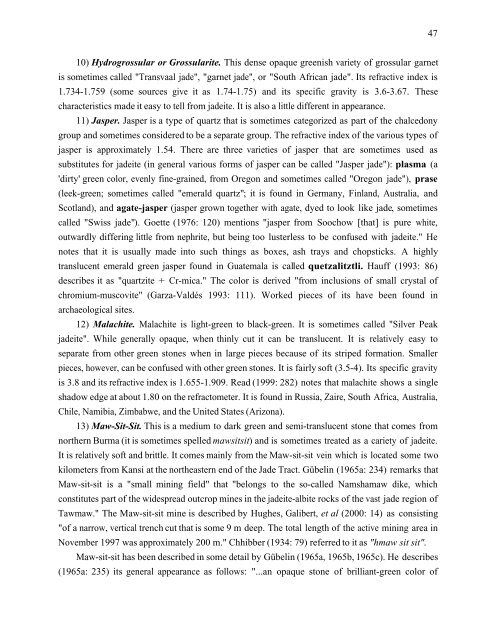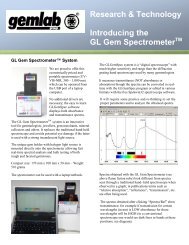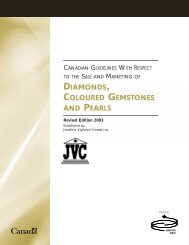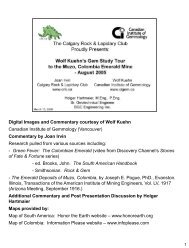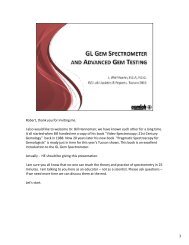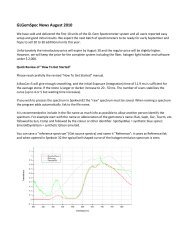JADEITE - Canadian Institute of Gemmology
JADEITE - Canadian Institute of Gemmology
JADEITE - Canadian Institute of Gemmology
You also want an ePaper? Increase the reach of your titles
YUMPU automatically turns print PDFs into web optimized ePapers that Google loves.
10) Hydrogrossular or Grossularite. This dense opaque greenish variety <strong>of</strong> grossular garnet<br />
is sometimes called "Transvaal jade", "garnet jade", or "South African jade". Its refractive index is<br />
1.734-1.759 (some sources give it as 1.74-1.75) and its specific gravity is 3.6-3.67. These<br />
characteristics made it easy to tell from jadeite. It is also a little different in appearance.<br />
11) Jasper. Jasper is a type <strong>of</strong> quartz that is sometimes categorized as part <strong>of</strong> the chalcedony<br />
group and sometimes considered to be a separate group. The refractive index <strong>of</strong> the various types <strong>of</strong><br />
jasper is approximately 1.54. There are three varieties <strong>of</strong> jasper that are sometimes used as<br />
substitutes for jadeite (in general various forms <strong>of</strong> jasper can be called "Jasper jade"): plasma (a<br />
'dirty' green color, evenly fine-grained, from Oregon and sometimes called "Oregon jade"), prase<br />
(leek-green; sometimes called "emerald quartz"; it is found in Germany, Finland, Australia, and<br />
Scotland), and agate-jasper (jasper grown together with agate, dyed to look like jade, sometimes<br />
called "Swiss jade"). Goette (1976: 120) mentions "jasper from Soochow [that] is pure white,<br />
outwardly differing little from nephrite, but being too lusterless to be confused with jadeite." He<br />
notes that it is usually made into such things as boxes, ash trays and chopsticks. A highly<br />
translucent emerald green jasper found in Guatemala is called quetzalitztli. Hauff (1993: 86)<br />
describes it as "quartzite + Cr-mica." The color is derived "from inclusions <strong>of</strong> small crystal <strong>of</strong><br />
chromium-muscovite" (Garza-Valdés 1993: 111). Worked pieces <strong>of</strong> its have been found in<br />
archaeological sites.<br />
12) Malachite. Malachite is light-green to black-green. It is sometimes called "Silver Peak<br />
jadeite". While generally opaque, when thinly cut it can be translucent. It is relatively easy to<br />
separate from other green stones when in large pieces because <strong>of</strong> its striped formation. Smaller<br />
pieces, however, can be confused with other green stones. It is fairly s<strong>of</strong>t (3.5-4). Its specific gravity<br />
is 3.8 and its refractive index is 1.655-1.909. Read (1999: 282) notes that malachite shows a single<br />
shadow edge at about 1.80 on the refractometer. It is found in Russia, Zaire, South Africa, Australia,<br />
Chile, Namibia, Zimbabwe, and the United States (Arizona).<br />
13) Maw-Sit-Sit. This is a medium to dark green and semi-translucent stone that comes from<br />
northern Burma (it is sometimes spelled mawsitsit) and is sometimes treated as a cariety <strong>of</strong> jadeite.<br />
It is relatively s<strong>of</strong>t and brittle. It comes mainly from the Maw-sit-sit vein which is located some two<br />
kilometers from Kansi at the northeastern end <strong>of</strong> the Jade Tract. Gübelin (1965a: 234) remarks that<br />
Maw-sit-sit is a "small mining field" that "belongs to the so-called Namshamaw dike, which<br />
constitutes part <strong>of</strong> the widespread outcrop mines in the jadeite-albite rocks <strong>of</strong> the vast jade region <strong>of</strong><br />
Tawmaw." The Maw-sit-sit mine is described by Hughes, Galibert, et al (2000: 14) as consisting<br />
"<strong>of</strong> a narrow, vertical trench cut that is some 9 m deep. The total length <strong>of</strong> the active mining area in<br />
November 1997 was approximately 200 m." Chhibber (1934: 79) referred to it as "hmaw sit sit".<br />
Maw-sit-sit has been described in some detail by Gübelin (1965a, 1965b, 1965c). He describes<br />
(1965a: 235) its general appearance as follows: "...an opaque stone <strong>of</strong> brilliant-green color <strong>of</strong><br />
47


